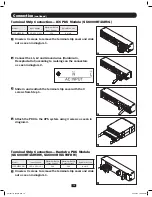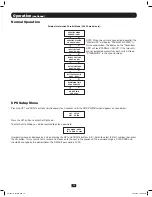
12
Optional Connection
The following connections are optional. Your UPS system will function properly without these connections.
1
RS-232 Serial and USB Communication Connections
Use the included cable to connect the power module’s “RS-232” port to the
communication port on your computer. This will allow full network monitoring and
control of your UPS system. Install on your computer the Tripp Lite PowerAlert software
appropriate to your computer’s operating system. The UPS is also equipped with a
USB communication module.
An alternate contact closure module is available if necessary (Tripp Lite part #
RELAYIOMINI). By default, this module is disabled. To enable, move both DIP switches
to the USB position. Enabling this module disables the RS-232 port. The RS-232 port
is also disabled with the installation of an optional SNMP/Web card (Tripp Lite part #
SNMPWEBCARD). The SNMP/Web card can be used simultaneously with the USB
communication module.
2
EPO Port Connection
This optional feature is only for those applications that require connection to a
facility’s Emergency Power Off (EPO) circuit. When the UPS is connected to this
circuit, it enables emergency shutdown of the UPS’s inverter and inhibits transfer
to internal bypass. Using the cable provided, connect the EPO port of your UPS
(see
2a
) to a user-supplied normally open switch according to the circuit diagram
(see
2b
).
Note
:
1. If using a cable other than what is supplied, the cable should not exceed 350 feet or have a resistance of greater than 10 ohms.
2. If a non-latching EPO switch is used, the EPO must be held for a minimum of 1 second. This does not apply to a latching EPO switch.
3. For setup of a normally closed-switch EPO connection, please contact Tripp Lite Technical Support.
CAUTION: The EPO port is not a phone line surge suppressor; do not connect a phone line to this port.
14
14
1
2a
Pins 4 and 5 or pins 2 and 3 can be
shorted to activate the EPO.
EPO connector
EPO Information
2b
201207113 933070.indb 12
9/17/2012 1:20:03 PM













































